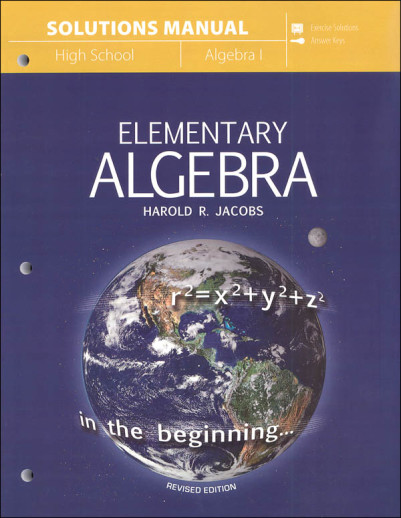We use cookies to make your experience better. To comply with the new e-Privacy directive, we need to ask for your consent to set the cookies. Learn more.
Elementary Algebra (Jacobs) Solutions Manual
The Elementary Algebra Solutions Manual offers the solutions for all of the exercises and chapter reviews. It does not offer test solutions.
An essential presentation of Elementary Algebra exercise solutions.
Includes answers for Sets I, II, III, and IV exercises, as well as the two final review test options
Helps expand understanding of key processes
This Solutions Manual goes beyond a simple answer key and shows the relationship of core concepts and algebraic formulas as they come together to reach required solutions.
Now published by Master Books, Harold Jacobs' Elementary Algebra is the same thorough algebra course it has always been. This course is the equivalent of Algebra 1 and covers the basic algebraic concepts from a review of operations and functions through quadratic equations and number sequences. The chapters are Fundamental Operations, Functions and Graphs, Integers, Rational Numbers, Equations in One Variable, Equations in Two Variables, Simultaneous Equations, Exponents, Polynomials, Factoring, Fractions, Square Roots, Quadratic Equations, Real Numbers, Fractional Equations, as well as Inequalities and Number Sentences. This is the same chapter sequence as found in the previous edition of this text. A midterm and final review are included in the text as well.
Master Books assures us that there have been no changes in content, even the problems in the exercises have remained the same. If you are familiar with the older text, one thing you will miss is some of the cartoons; however, some were kept in the text to add to the readability. A bit of humor never hurts! Although Master Books is a Christian company, this text doesn't include any Christian content.
Lessons in the Student Textbook begin with concepts, and Mr. Jacobs makes sure you understand the "why" before tackling the "how." The text's thorough explanation of bite-size amounts of information make this a very popular program for understandability. There are still four sets of exercises in each lesson. Set l reviews ideas from previous lessons for that continual review; Set II and Set III practice concepts taught in the lesson (Set III exercises are available as a supplement download from the publisher); Set IV can be optional or be used for extra credit since these offer challenge problems that go beyond the lesson. Answers to Set II exercises can be found in the back of the student book, which allows the student the option to self-grade.
There is no longer a solution manual to this curriculum – now the solutions to all problems in Sets I, II, and IV are included in the revised Teacher Guide. This guide also offers a suggested daily lesson schedule that allows you to finish the course in one academic year. Test A forms for use at the end of each chapter are also included. Tests are one page, front and back, and the number of problems varies by chapter. A midyear and final exam are also in the teacher guide: 80 problems each and 4 pages in length. Answers to the tests are included in the back of the teacher guide – not solutions, just answers.
Set III problems are available for extra practice. These problems and three other versions of chapter tests (B, C, and D) are available to purchase as a “supplement” download directly from the publisher. Problems are similar in each test and cover the concepts of that chapter. There is some variation in the numbers used in the different tests. The question might say, "Use the property named to write another expression equivalent to x(x+8) in Test A. However, in Test B, it says, "Use the property named to write another expression equivalent to x(x+3) or in Test C, x(x-6).
Harold Jacobs' math courses have a long-standing reputation for thorough explanations and it is nice to see them back on the market! ~ Donna
| Product Format: | Softcover Book |
|---|---|
| Brand: | Master Book Publishers |
| Author: | Harold R. Jacobs |
| Grades: | 9-10 |
| ISBN: | 9780890519875 |
| Length in Inches: | 10.8125 |
| Width in Inches: | 8.375 |
| Height in Inches: | 0.5625 |
| Weight in Pounds: | 1.45 |

